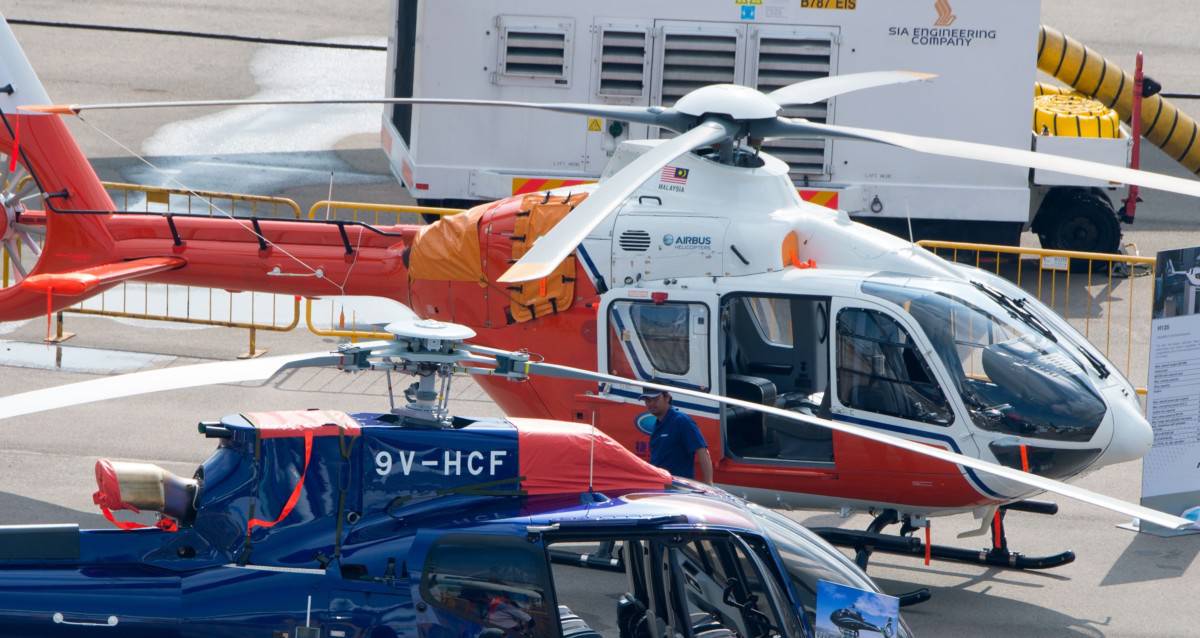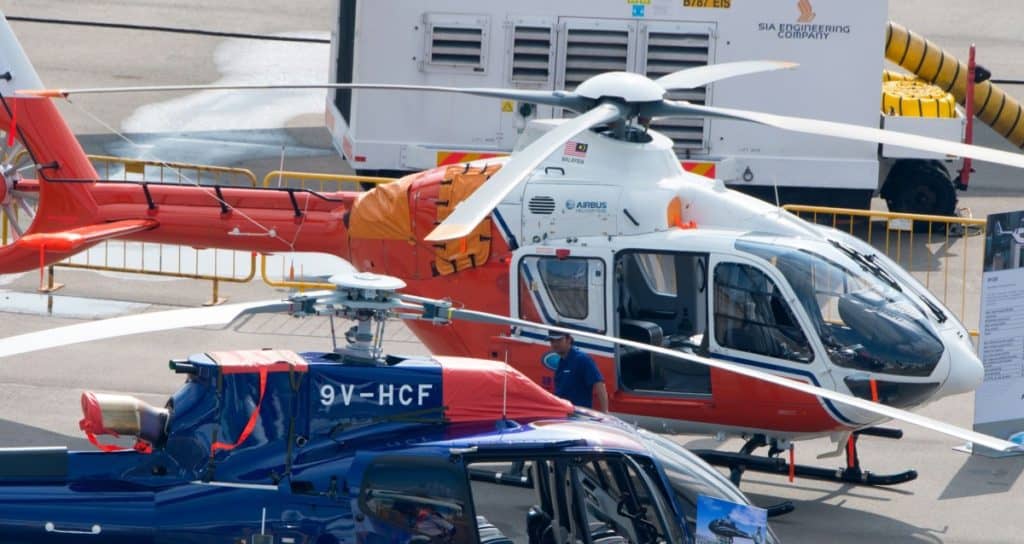
As the decades of helicopter design have passed so too seem to be the number of blades appearing on helicopters. Two main rotor blades were once a common design but now we see helicopters with up to 8 main rotor blades. So why more?
Helicopters have between 2 and 8 main rotor blades. The larger the helicopter, the heavier it weighs and needs more lift to be produced. By using more blades, designers can increase the entire rotor system surface area while keeping the size of each rotor blade as small as possible.
There is no magic number to how many rotor blades a helicopter can have and playing with the trade-offs is how helicopter designers come up with the number of blades each helicopter design will have.
To understand these trade-offs let’s look at why some helicopters have 2 main rotor blades when others have 3, 4, or even 8…
Blade Design Characteristics
The main rotor blades on a helicopter are designed to do one thing: Lift the helicopter, its passengers, and its cargo. But, it is not just that one facet, helicopter designers also need to think about a few other factors:
- Keeping costs low
- Using as few parts as possible
- Keeping the weight of the rotor system down
- Ensuring drag created by the blades is minimal
- Keep noise to a minimum
- Keep vibration to a minimum
As you can see there are a lot of things the designers have to think about when they design the helicopters rotor system, let alone the insane amount of aerodynamic factors that also come into play!
Taking into account these factors above let’s look at some rotor blade fundamentals:
The bigger the rotor blade, the more lift it produces, but it also weighs more, requires more materials, costs more, creates more drag as it moves through the air, and requires more power to overcome that drag.
The Longer the rotor blade, the more it droops when not rotating. The more centrifugal force will act upon it. The faster the blade tip will travel.
So these observations may be obvious but each aspect can mean the difference between the design team having to add another blade to the rotor head or not.
What are Rotor Blade Design Limitations?
To add to the basic design principles mentioned above rotor blades create their own aerodynamic problems as they operate. Each one of these problems has to be overcome to design an efficient rotor blade.
Here are just some of the aerodynamic limitations to rotor blade design:
- Blade Tip Vortices
- Wake Turbulence
- Static-Blade Droop
- Centrifugal Loading
- Vibration
Blade Tip Vortices
Main rotors have to be spun at an optimum RPM to produce the maximum amount of lift for the least amount of power. The longer the Span or length of the blade, the faster the blade tips will travel.
The tip speed of a rotor blade also increases as the helicopter itself goes faster. This is because the air meeting the rotor blade on the Advancing Side of the helicopter has its own forward aircraft speed plus the rotational speed of the rotor blade itself.
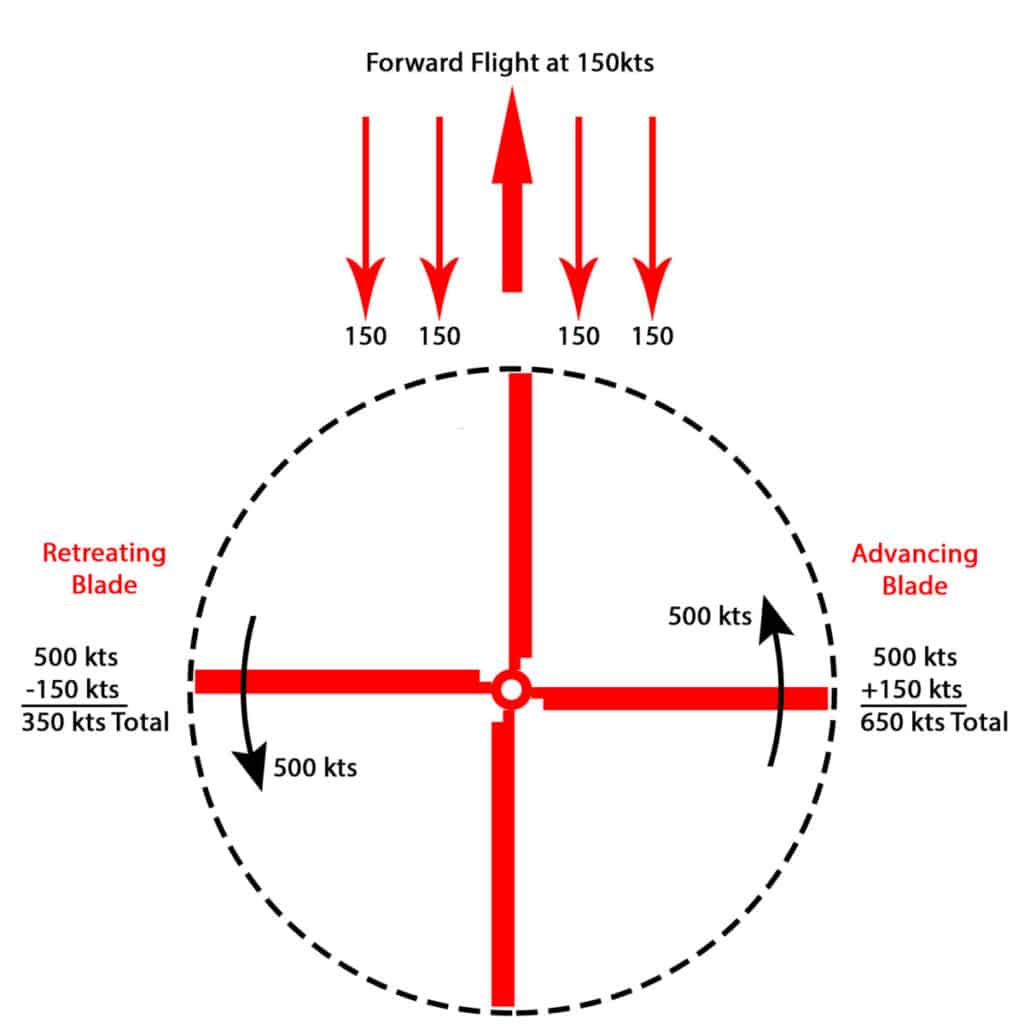
The speed of sound is around 666 kts and as the tip of the Advancing Rotor Blade reaches this speed it begins to break the sound barrier and create shockwaves. These shockwaves disturb the airflow and create huge amounts of drag.
The blade tip has now gone from producing lift to now creating drag. This reduction in lift not only reduces the lifting power of the rotor blade but also increases sound and vibration – Two further unwanted aspects of a helicopter!
To overcome this problem, designers can either reduce the Span (length) of the blade, rotate it slower, reduce the helicopter’s top speed, or design a rotor blade tip that helps reduce the shock wave.
Modern-day helicopters are being designed with these odd-looking blade tips to help improve blade performance:
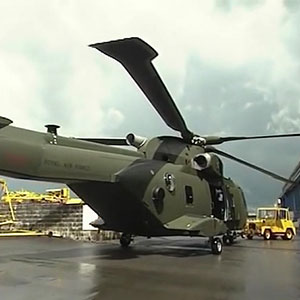
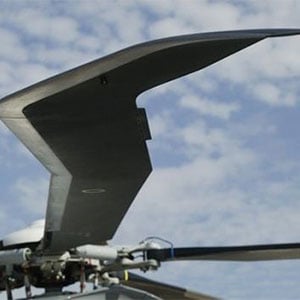
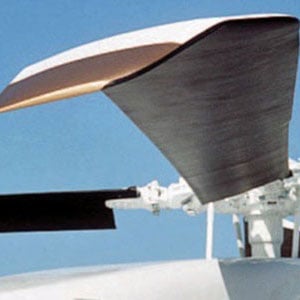
Wake Turbulence
For a rotor blade to work as efficiently as possible it needs undisturbed air passing over it. Lumpy, disturbed, and irregular airflow over the blade will reduce the lift it produces.
As each rotor blade passes through the air it creates turbulence that it leaves behind in its wake. A helicopter with many rotor blades may not allow the air to get a chance to be replaced with smooth, undisturbed air before the next blade reaches it.
To help overcome this on very large multi-bladed helicopters designers and engineers adjust the plane in which half the blades rotate in. One blade rotates on a lower plane, the next blade on a higher plane, the next on a lower plane, the next on a higher plane, and so forth.
This helps provide more undisturbed air for each blade to work on. For the smaller helicopters, this can be overcome with the design of the rotor blade itself.

Join My Newsletter & Get Great Tips, Information and Experiences To Help You Become a Superb Pilot!
Static Blade Droop
The longer the span of the blade, the more it is going to bend or droop when it is not rotating. When in flight, centrifugal force keeps the rotor blade flat but getting it up to the speed where centrifugal force kicks in can be problematic, especially in gusty wind conditions.

The lower a blade droops during slow rotation the more chances are that it can contact the tail boom causing serious catastrophic damage but it can also be very hazardous to any person walking around the aircraft.
Gusty winds can catch a rotor blade and cause it to flap up and down before the centrifugal force has taken effect. Many helicopter tail booms have been hit due to starting or stopping a helicopter in gusty winds. For this reason, many helicopter manufacturers will issue a maximum wind speed for stopping and starting the rotors.
Another way helicopter designers can prevent the blades drooping too low during slow rotation is to add ‘Droop Stops’ to the rotor head, under each rotor blade. These are spring-loaded wedges that the blade grips rest on when in slow rotation.
As the rotor head begins to spool up, centrifugal force overcomes the spring and rotates the Droop Stops out of the way so the blade has full vertical movement in flight.
Centrifugal Loading
The larger the rotor blade the more mass it has. As the mass begins to rotate the centrifugal force will increase. The amount of force trying to rip the rotor blade from the rotor head can be immense.
To handle these forces the blade, the blade root, the blade grip, and the rotor head have to be strong enough to hold the blade tight. The stronger the material and designed strength of each one of those parts will increase, the material and machining required increases and the overall weight of the rotor head can be increased, especially on large helicopters.
The smaller the blade, the less force it will exert on all of its components.
Vibration
As a rotor blade moves through the air and creates lift it resonates and produces vibrations. The larger the rotor blade, the lower the vibration frequency will be. You have all heard this when a Huey is in flight and its infamous ‘Whop-Whop’ thunders around the sky.
This low-frequency vibration is also felt when flying in the aircraft and it feels like you are constantly bouncing on an exercise ball – especially if the rotor head is not tracked and balanced properly!
The more blades a helicopter has, the higher the resonant frequency becomes because the blades are smaller and they rotate at a higher RPM. There can also be a problem when the resonant frequency of the rotor head matches the resonant frequency of the fuselage if this condition is allowed to develop it can lead to a problem called Ground Resonance. The onset of an ever-increasing ground resonant frequency can destroy a helicopter if not recovered quickly enough.
This video shows Ground Resonance on an Astar:
To help overcome catastrophic resonant vibration from developing designers use strategically placed and tuned weights or hammers throughout the rotor head and airframe to counteract vibrations in certain axis or locations.
A higher resonant aircraft and rotor head frequency lead to a quieter helicopter and a smoother ride which is very important in today’s world.
For those of you that have flown in a 2-bladed helicopter and then a multi-bladed helicopter you will instantly feel the difference in the smoothness of the ride!
Learn More…
Try These Articles:
* What Is A Helicopter Blade Made of? It Used To Be Wood!
* How Do Helicopter Controls Work? Pilot Tells All!
What is Rotor Blade Loading?
To lift the helicopter and its cargo off the ground the rotor system as a whole must create enough lift to overcome the weight. Each individual blade can only lift so much. The load imposed on a rotor blade as it begins to lift the helicopter is called Rotor Blade Loading.
To calculate this we take the Maximum Gross Weight of the helicopter and divide it by the surface area the blades have then divide that amount by the number of main rotor blades it has.
Let’s look at some helicopter examples:
| Helicopter | Maximum Gross Weight | Disk Surface Area | Disk Load | # Main Rotor Blades | Single Blade Load |
|---|---|---|---|---|---|
| Robinson R22 | 1,370 lb 622 kg | 497 ft² 46.2 m² | 2.76 lb/ft² 13.46 kg/m² | 2 | 1.38 lb/ft 6.73 kg/m² |
| Bell 206 Jet Ranger | 3,350 lb 1,520 kg | 872 ft² 81.1 m² | 3.84 lb/ft² 18.74 kg/m² | 2 | 1.92 lb/ft² 9.37 kg/m² |
| Eurocopter AS350 Astar B3 | 4961 lb 2250 kg | 966.1 ft² 89.75 m² | 5.14 lb/ft² 25.07 kg/m² | 3 | 1.71 lb/ft² 8.36 kg/m² |
| Bell 212 | 11,200 lb 5,080 kg | 1,809.5 ft² 168.11 m² | 6.17 lb/ft² 30.22 kg/m² | 2 | 3.09 lb/ft² 15.11 kg/m² |
| Airbus H135T2+ | 6,415 lb 2,910 kg | 879 ft² 81.7 m² | 7.30 lb/ft² 35.62 kg/m² | 4 | 1.82 lb/ft² 8.90 kg/m² |
| Sikorsky S61N | 19,000 lb 8,620 kg | 3,019 ft² 280.6 m² | 6.29 lb/ft² 30.72 kg/m² | 5 | 1.26 lb/ft² 6.14 kg/m² |
| Mil Mi-26 | 123,459 lb 56,000 kg | 8,656.9 ft² 804.25 m² | 14.26 lb/ft² 69.63 kg/m² | 8 | 1.78 lb/ft² 8.70 kg/m² |
As you can see in the table above most helicopter designers try to get each blade load to around 1-2 lb/ft² or 6-9 kg/m² apart from the Bell 212. This has a much higher blade loading because it is a heavy aircraft with only 2 blades to lift that weight. This was probably one of the main reasons why Bell increased the rotor head to 4 blades when they developed the Bell 412.
The Bell 212, Bell 214 & Bell AH-1 Cobra have some of the largest blades that a 2-blade rotor system can physically be.
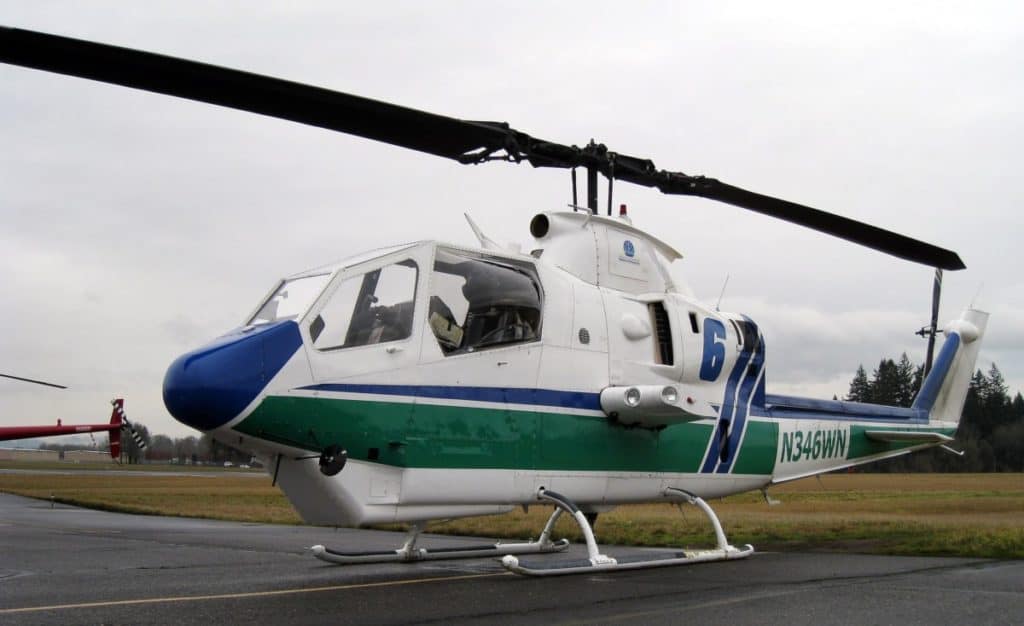
To lift large amounts of weight more blades are required to spread the load. But more blades bring more problems!
Fewer Blades Vs More Rotor Blades
For smaller helicopters, a two-bladed or 3-bladed rotor system gives the best option as the disk load is easily overcome with fewer blades. This makes design easier, costs less, uses fewer parts, and weighs less.
The drag created by fewer blades as they pass through the air is also easily overcome by the less-powerful piston engines. This is the main reason why most training helicopters are small 2 and 3 bladed, piston-powered machines. They offer the cheapest running cost per hour.
When more power is required to lift a heavier helicopter then a switch to a small but powerful Gas-Turbine engine is the choice of most designers.
As the size of the helicopter increases there will become a point where the minimum number of blades required to spread the disk load will reach its limit. These limits of aerodynamic and physical blade design will dictate when one or more blades will have to be added.
Take the Mil-Mi26 helicopter for example. For this helicopter to only have 3 or 4 blades, the physical size of each rotor blade would be so large that even with modern-day materials they would still not be able to be manufactured to be efficient and work safely.
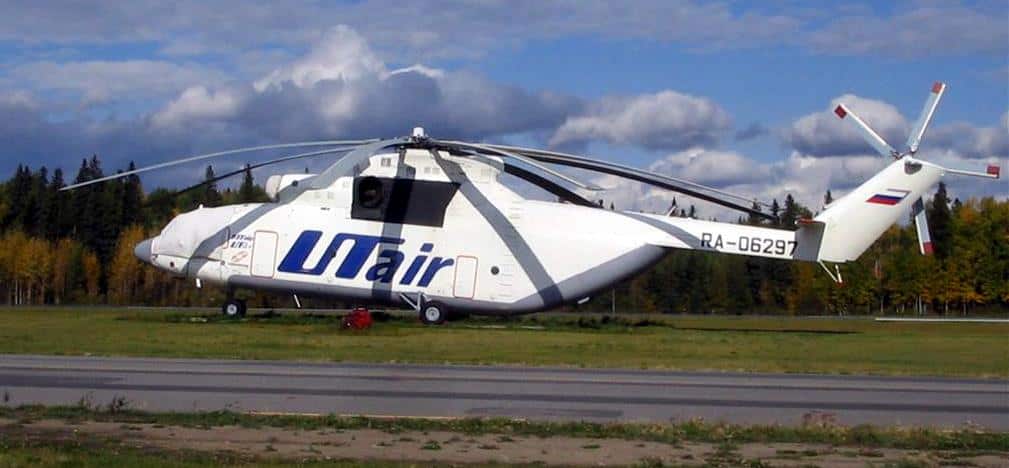
The blades are already 50ft long with 8 blades! With only 4 blades, both the width (Chord) and the length (Span) of each blade would have to be dramatically increased and even if a blade could be designed to work effectively and safely, the area required for this machine to land would be far too large for most construction sites where this machine is primarily used.
Everything is a trade-off and deciding which factors are more important than others is battled out between the helicopter designers and the engineers. Each helicopter design has a specific role and customer in mind so the design of its rotor head, as well as many other items, will be largely influenced by its potential market.
Learn More…
Try These Articles:
* Can Helicopters Fly at Night? A Pilot Tells All!
* Helicopters: Can They Fly Across an Ocean?
Helicopter Rotor Blade Case Study – Airbus H145:
A great example of more blades or fewer blades on a helicopter has been showcased in recent years with the Airbus H145. This was originally designed with a 4 blade rotor system.
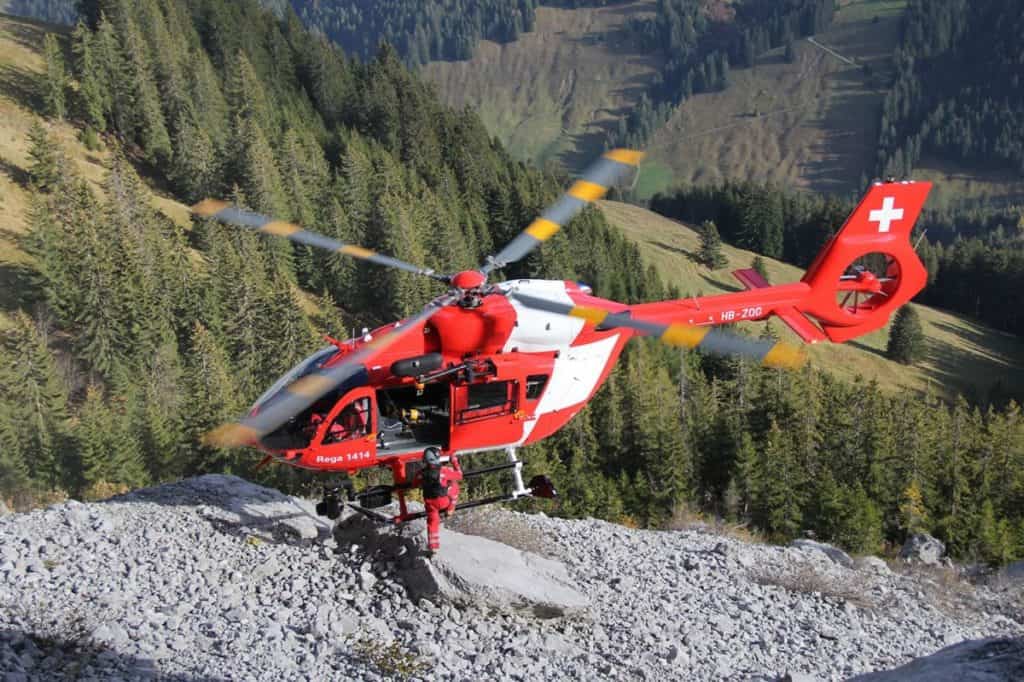
Due to its increasing popularity and pressure from Airbus’s customers for an increase to its useful load, Airbus went back to the drawing board to see how an upgrade could be made to satisfy their demands.
To be released in 2020, a new 5 blade rotor system was designed and developed and is available straight from the factory or via a 250 man-hour upgrade kit to existing 4 blade H145’s.
Using new design techniques and materials Airbus was able to create the following improvements to the original H145:
- 5 blade rotor system with no rotor hub. Blades attach directly to the mast.
- New design reduced Aircraft Empty Weight by 110 lb (50 kg)
- Total useful Payload increase from 8,160 lb to 8,380 lb (3,700 kg to 3,800 kg)
- Improved blade design allows for Blade Folding
- Reduction in vibration for improved ride quality
- Removal of Active Vibration Control System (LAVCS)
- All expensive and complex parts of the blade in the blade root, only tips need to be changed after ‘Hanger Rash’
- No lifetime limit on new blades – Replace on Condition
- Reduced Rotor Disk Diameter from 36ft1″ to 35ft5″
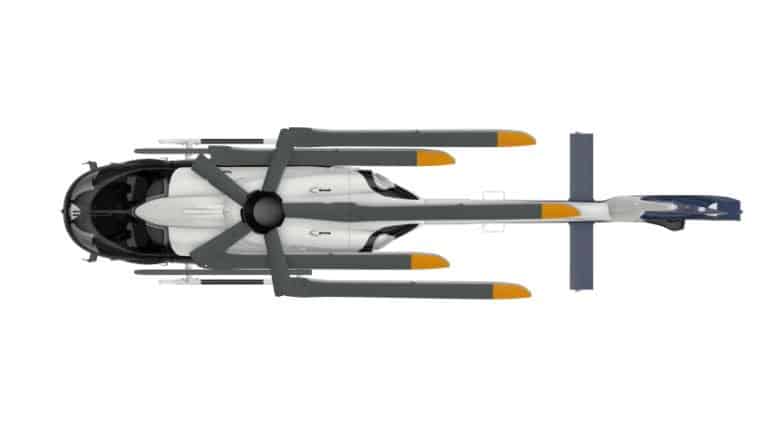
By increasing the rotor blades from 4 to 5, Airbus have been able to deliver to their customers an improvement on an already very-designed helicopter.
Using new design methods and materials the additional weight and complexity of adding a new blade were minimalized by the fact that 110 lb (50 kg) were saved by the removal of equipment and elimination of a conventional rotor head.
In a recent interview with Vertical Magazine at the launch for the 5 blade H145 upgrade, Axel Humpert, head of the H145 program was asked “Why not six blades for the upgrade?” to which he replied “If I had a sixth blade, the useful load would not increase by 150 kilograms, It would increase by less, but add more complexity to the mechanical and aerodynamic design. We achieved the target with five blades.”
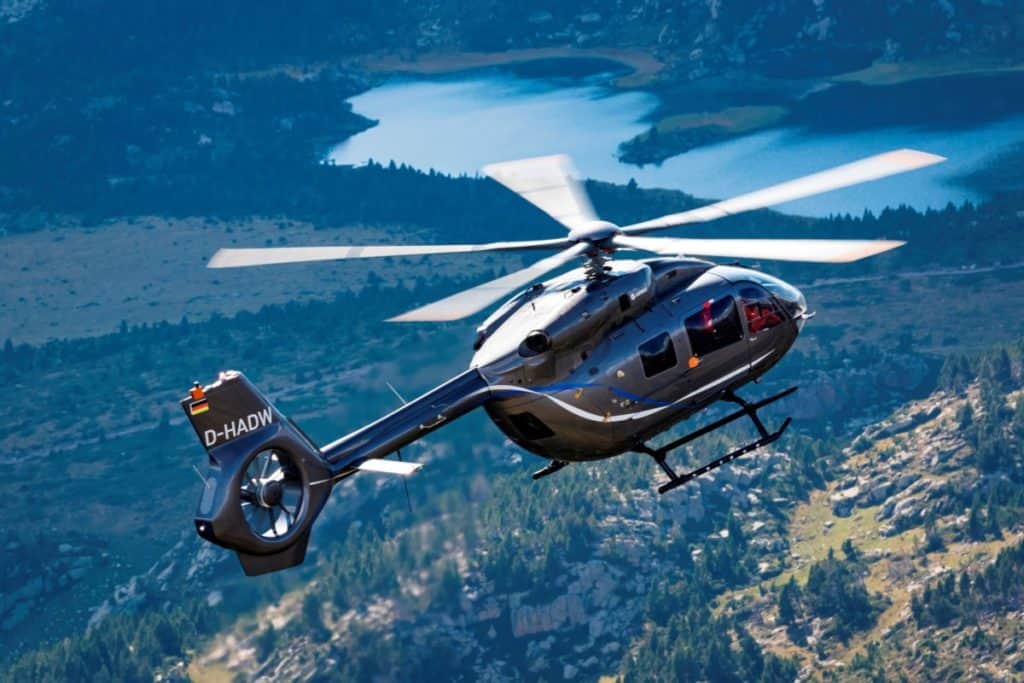
Get Your Free Copy of the H145
5 Blade Upgrade Brochure Right Here:
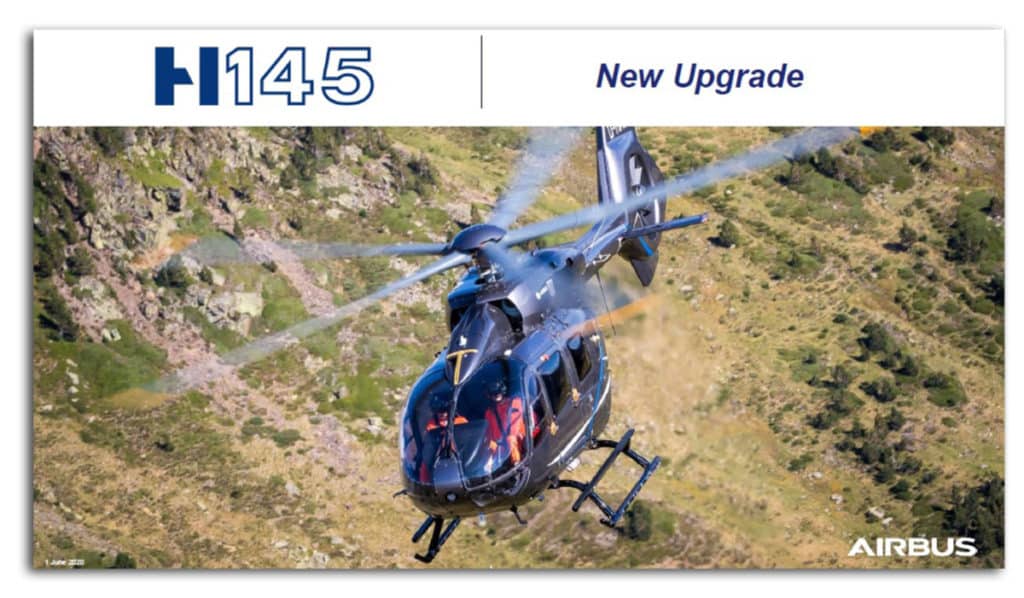
To Finish
Helicopter rotor head design is all about meeting the economic, aerodynamic, and physical requirements of a target market. Once a number of rotor blades have reached one of these limits then the design has to advance to additional blades.
With modern design and manufacturing techniques, materials and technological advances rotor blades are becoming increasingly more efficient while producing less drag, less vibration, and less noise.
There is a limit on how many blades are the most efficient solution for each helicopter design but I can see the two-bladed rotor heads become a thing of the past as the more efficient multi-blade heads roll off the production lines.
Header Image:
Airbus H135 & H125 Singapore Airshow – Source: Airbus Helicopters

